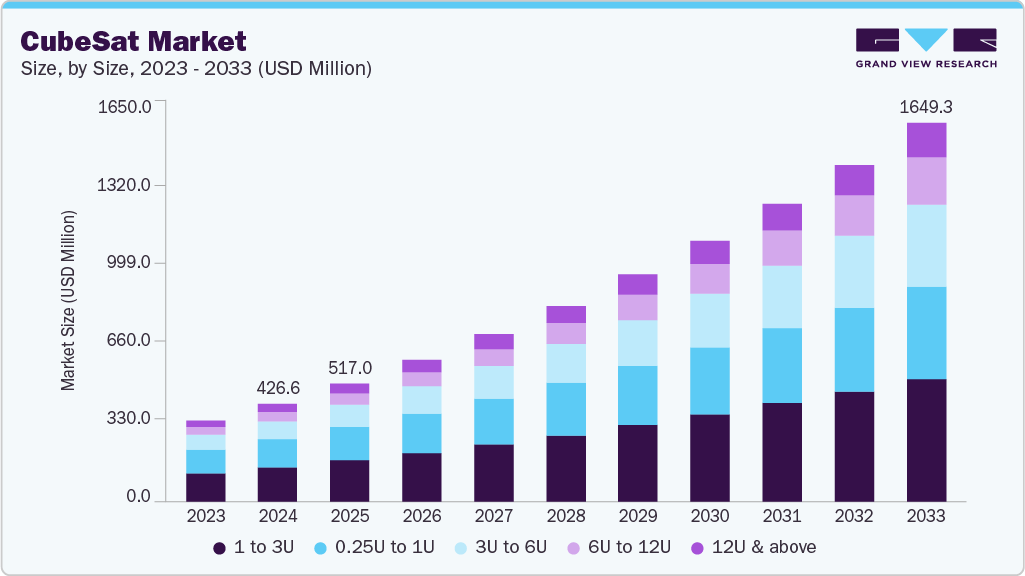The global CubeSat market was valued at USD 426.6 million in 2024 and is projected to reach USD 1,649.3 million by 2033, growing at a CAGR of 15.6% from 2025 to 2033. Growth is driven by the rising demand for low-cost satellite missions, increased use in Earth observation and remote sensing, and rapid advancements in miniaturized satellite technology.
The surge in Earth observation needs—spanning agriculture, climate monitoring, and urban planning—is generating new opportunities. Government and private players are turning to CubeSats for cost-effective, high-accuracy data collection, supported by high-resolution payloads and rapid constellation launches.

Additionally, the CubeSat market is gaining momentum from space-based IoT applications. Sectors such as agriculture, maritime, and energy rely on satellite networks for remote asset tracking and low-latency communication. This has accelerated innovations in CubeSat constellations, reinforcing their role in building a global IoT infrastructure.
Key Market Insights:
- North America led the CubeSat market with over 46.0% revenue share in 2024, supported by advanced space infrastructure and growing demand for low-orbit connectivity.
- By size, the 1 to 3U segment held over 35% of the market in 2024, offering an optimal balance between compact design and functional performance, making it ideal for Low-Earth Orbit (LEO) missions.
- By application, Earth observation remained the dominant segment in 2024 due to increasing demand for real-time environmental data.
- By subsystem, the payload segment led in 2024, driven by needs for advanced imaging, sensing, and communication technologies.
- By end-use, the government & defense sector was the largest contributor in 2024, leveraging CubeSats for cost-effective, flexible, and rapid-deployment missions.
Order a free sample PDF of the CubeSat Market Intelligence Study, published by Grand View Research.
Market Size & Forecast
- 2024 Market Size: USD 426.6 Million
- 2033 Projected Market Size: USD 1,649.3 Million
- CAGR (2025-2033): 15.6%
- North America: Largest market in 2024
Key Companies & Market Share Insights
Key players in the CubeSat market include Planet Labs Inc., GomSpace, and emerging participants like EnduroSat and Space Inventor.
- Planet Labs Inc. operates one of the world’s largest commercial CubeSat fleets, delivering high-resolution Earth imagery for agriculture, defense, climate, and disaster monitoring. Its Dove and SuperDove satellites provide near real-time insights at scale.
- GomSpace (Denmark) is a leading CubeSat manufacturer offering propulsion, ADCS, radios, and power systems. It serves global commercial and government clients with reliable, advanced subsystems.
- EnduroSat is gaining traction with its modular CubeSat platforms and shared satellite services, enabling cost-effective multi-payload missions for commercial, academic, and IoT users.
- Space Inventor, a Danish startup, focuses on modular, high-performance subsystems like EPS and ADCS, providing customizable CubeSat solutions for both commercial and governmental missions.
Key Players
- GomSpace
- Innovative Solutions In Space B.V.
- L3Harris Technologies Inc.
- Planet Labs Inc.
- Pumpkin Space Systems
- Space Inventor
- SpaceX
Explore Horizon Databook – The world's most expansive market intelligence platform developed by Grand View Research.
Conclusion
The CubeSat market is experiencing substantial growth due to increased demand for cost-effective satellite missions, particularly in Earth observation and remote sensing. Advancements in miniaturized satellite technology are also contributing to this expansion. While North America currently leads the market, the commercial sector is projected to be the fastest-growing end-use segment. Key applications include Earth observation and communication, with a notable rise in interest for space-based IoT applications. Regulatory frameworks and investments from both government and private entities are further propelling the industry forward, making CubeSats increasingly vital for various monitoring and intelligence purposes.





